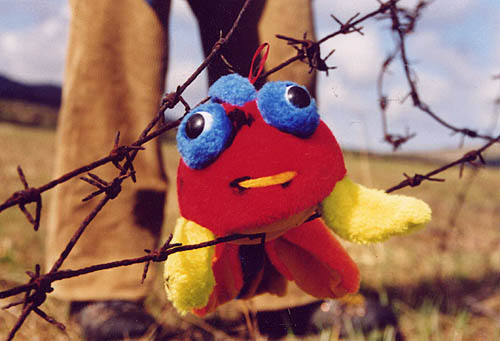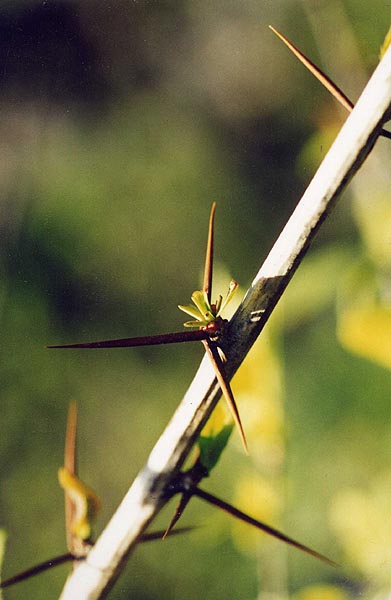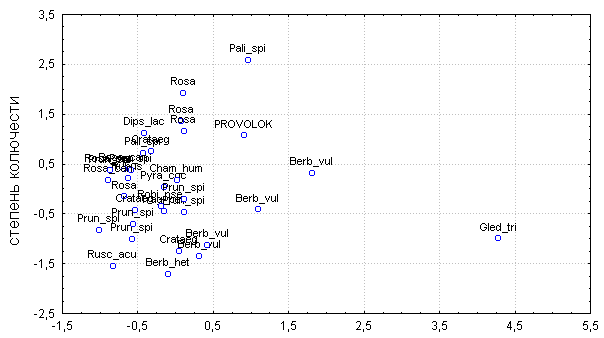
Blackthorn bush is my sweet home, Brother Fox!
Harris D. "Uncle Rimus fairy-tales"
Vegetative plant organs can carry out not only main functions but also additional ones. When additional functions predominante over main ones, or some new functions appear, the organ changes greatly by its morphological and anatomical features. Shoot is able to change in various ways, what is connected with its multifunctionality and also with its flexibility in different environmental conditions. The thorn is very common type of the stem changing. Thorn is a solid, frequently wooden leafless shorten shoot with sharp apex (like thorns of blackthorn, hawthorn, acacia and many others). We can also call thorns emergences, which are built of epidermis and subepidermal tissues (for example, thorns of rose, gooseberry and blackberry) [1], [3].
The goal of the current work was a comparative analysis of biomechanical properties of different spiny plants species, which grow on the hiking-routes, in the vicinities of settlements and other places of people activities.
This work took part from 3 to 10 May 2002 in vicinities of Yalta, Big Kan'on, Aj-Petri yajla (Crimea) and from 17 to 20 May 2002 near village Turovo (Moscow region). We determine the investigated plants to the species or to the genera, if more exact determination was hard because of fenological stage of the plant. We investigated barbed wire with same methods as the best example of thorness degree and delaying ability from the human point of view.
We have worked out the original method for the objective estimation of the plant's thorness degree and their delaying possibility. We marked the shape of the thorn's spike (fig. 1), thorn's shape (branched or simple), measured the length of maximal thorn and the height of the plant, and also counted maximal number of thorns, proecting on the square 10 cm x 10cm, for each groop of investigated plants.
Figure 1. Spike kinds (from left to right): flat, conic, nail-like, bent

We measured an effort, taking place while lifting the model object from the bush, pulling it in and out the bush in the horizontal direction. The model object was plush toy with weight of 60 gramms and 8 cm õ 13 cm õ 6 cm large with various parts from 6 to 12 cm long (fig. 2, 3).
Figure 2. The model object during the measurements in the blackthorn bush

Figure 3. The model object during the measurements in the barbed wire

We considered lifting, pulling in and out finished, if the model object remarkably mooved in the current dirrection. We measured the effort by scales "Pesola" (error +/-0,3%). If the maximum possible effort in 1,5 kg was reached and the model object remained mooveless, the effort was registred as 1,5kg. We recalculated kilogramms into Newtons. We substracted the weight of the model object from the lifting effort. We calculated the projective thorn density of the plant (the number of thorns, with spikes projected on one square cantimeter). We also calculated two values, allowing us completely estimate the thorness degree of the plants and their delaying ability: absolute thorness coefficient (Kak):

where Nk - projective thorn density, Lk - length of the maximum thorn, hpact - height of the plant (table 1).
Table 1. Maximum values of absolute thorness coefficient for the each investigated plant taxon
| Taxon | Êak |
|---|---|
| Berberis vulgaris | 5,775 |
| Rosa sp. | 3,098 |
| Prunus sp. | 2,437 |
| Crataegus sp. | 2,894 |
| Rubus caucasicus | 0,894 |
| Ruscus aculeatus | 0,361 |
| Pyracantha sp. | 0,490 |
| Dipsacus laciniatus | 1,760 |
| Berberis heterophyllum | 1,984 |
| Chamaerops humilis | 1,697 |
| Paliurus spina-Christi | 2,925 |
| Tragacantha pentacantha | 0,863 |
| Gleditsia triacanthos | 31,937 |
| Robinia pseudoacacia | 9,165 |
| barbed wire | 2,884 |
relative thorness coefficient (Êok):

Table 2. Maximum values of relative thorness coefficient for each of the investigated plant taxon
| Taxon | Êok |
|---|---|
| Berberis vulgaris | 3,850 |
| Rosa sp. | 1,549 |
| Prunus sp. | 0,975 |
| Crataegus sp. | 1,158 |
| Rubus caucasicus | 0,894 |
| Ruscus aculeatus | 0,721 |
| Pyracantha sp. | 0,980 |
| Dipsacus laciniatus | 1,466 |
| Berberis heteriphyllium | 1,323 |
| Chamaerops humilis | 1,697 |
| Paliurus spina-Christi | 1,720 |
| Tragacantha pentacantha | 2,877 |
| Gleditsia triacanthos | 3,194 |
| Robinia pseudoacacia | 0,917 |
| barbed wire | 1,442 |
We calculated correlation coefficients and perfomed factor analysis for our data. We analyzed nonparametric Spearman correlation coefiicients, because the distribution of our data wasn't normal. Statistical data proceeding was made with help of STATISTICA program package (version STATISTICA 5.5 for Windows).
We have found strict connection between absolute thorness coefficient and effort of pulling the model object in and out the bush (N=33, R=0,4, p<0,05), and also less trustworthy connection between this coefficient and effort of lifting the model object from the bush (N=33, R=0,33, p=0,057). We haven't found any trustworthy connection between all that efforts and characters from the formula for absolute thorness coefficient (p>0,1), besides strict connection between the lifting effort and plant's height (N=33, R=0,4, p<0,05). Consequently, this absolute thorness coefficient lets us estimate dalaing plant abbility better then separate characters of spiny plants. Relative thorness coefficient lets us estimate the thorness degree pf the plant.
The analysis of maximal values of thorness coefficient lets us mark the following facts (table 1, 2). Value of absolute thorness coefficient for Gleditchia triacanthos and for Robinia pseudoacacia is much greater then this values for all the other investigated taxons. This result, from the one hand, is explained by great contribution of these trees height in the coefficient value. From the other hand, the relative thorness coefficient value for G. triacathos (in the difference from R. pseudoacacia) also is very high, what shows us exellent delaying ability and great thorness degree of G. triacanthos. Probably, this is caused that "in Russia this species has been cultivated since the beginning of 19 century and now is met frequently in greenery of cities and towns" [2]. Enough high values of both thorness coefficients are marked for Berberis vulgaris (fig. 4). It is not suprising, that "its pretty bushes decorate parks, gardens and lawns if not to say all, then almost all cities of our country" [2]. The thorness coefficients values for G. triacanthos and B. vulgaris exceed this values for barbed wire. The values of absolute thorness coefficient, that are near to these values for the barbed wire, were marked for Prunus sp., Crataegus sp., Rosa sp. (fig. 5) and Paliurus spina-Christi. This property of the above mentioned species has been marked by people long time ago, the thickets of these plants "were successfully used for making dense impassable hedges" [2].
Figure 4. The thorns of Berberis vulgaris

Figure 5. The thorns of Rosa sp.

High value of the relative thorness coefficient was marked for Tragacantha pentacantha, but small height of this extreemely spiny plant essentially reduces its delaying ability. The values of relative thorness coefficient, that are near to this value for the barbed wire, were marked for Rosa sp., Dipsacus laciniatus, Berberis heterophyllum, Chamaerops humilis and Paliurus spina-Christi.
The factor analysis of our data shows us that the plants from the same taxon don't form distinct groups (fig. 6). This result informs us about the dependence of our results not only on the systematic status of the plant, but also on its condition (age, height, density of the bush). We should exceed number of investigated plants to get more trustworth results.
Figure 6. Distrubution of the investigated plants according to their thorness degree and delaying ability (factor analysis)

This work was made during biological practices of Moscow South-West High School (# 1543). We thank Abramova L. and Snetkova N., who helped us a lot during our field work.